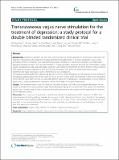| dc.contributor.author | Rong, Pei-Jing | |
| dc.contributor.author | Fang, Ji-Liang | |
| dc.contributor.author | Wang, Li-Ping | |
| dc.contributor.author | Meng, Hong | |
| dc.contributor.author | Ma, Ying-ge | |
| dc.contributor.author | Ben, Hui | |
| dc.contributor.author | Li, Liang | |
| dc.contributor.author | Liu, Ru-Peng | |
| dc.contributor.author | Huang, Zhan-Xia | |
| dc.contributor.author | Zhao, Yu-Feng | |
| dc.contributor.author | Liu, Jun | |
| dc.contributor.author | Li, Xia | |
| dc.contributor.author | Zhu, Bing | |
| dc.contributor.author | Kong, Jian | |
| dc.date.accessioned | 2013-05-09T14:52:16Z | |
| dc.date.issued | 2012 | |
| dc.identifier.citation | Rong, Pei-Jing, Ji-Liang Fang, Li-Ping Wang, Hong Meng, Jun Liu, Ying-ge Ma, Hui Ben, et al. 2012. Transcutaneous vagus nerve stimulation for the treatment of depression: A study protocol for a double blinded randomized clinical trial. BMC Complementary and Alternative Medicine 12:255. | en_US |
| dc.identifier.issn | 1472-6882 | en_US |
| dc.identifier.uri | http://nrs.harvard.edu/urn-3:HUL.InstRepos:10612945 | |
| dc.description.abstract | Background: Depressive disorders are the most common form of mental disorders in community and health care settings. Unfortunately, the treatment of Major Depressive Disorder (MDD) is far from satisfactory. Vagus nerve stimulation (VNS) is a relatively new and promising physical treatment for depressive disorders. One particularly appealing element of VNS is the long-term benefit in mood regulation. However, because this intervention involves surgery, perioperative risks, and potentially significant side effects, this treatment has been limited to those patients with treatment-resistant depression who have failed medication trials and exhausted established somatic treatments for major depression, due to intolerance or lack of response. This double-blinded randomized clinical trial aims to overcome these limitations by introducing a novel method of stimulating superficial branches of the vagus nerve on the ear to treat MDD. The rationale is that direct stimulation of the afferent nerve fibers on the ear area with afferent vagus nerve distribution should produce a similar effect as classic VNS in reducing depressive symptoms without the burden of surgical intervention. Design: One hundred twenty cases (60 males) of volunteer patients with mild and moderate depression will be randomly divided into transcutaneous vagus nerve stimulation group (tVNS) and sham tVNS group. The treatment period lasts 4 months and all clinical and physiological measurements are acquired at the beginning and the end of the treatment period. Discussion: This study has the potential to significantly extend the application of VNS treatment for MDD and other disorders (including epilepsy, bipolar disorder, and morbid obesity), resulting in direct benefit to the patients suffering from these highly prevalent disorders. In addition, the results of this double-blinded clinical trial will shed new light on our understanding of acupuncture point specificity, and development of methodologies in clinical trials of acupuncture treatment. | en_US |
| dc.language.iso | en_US | en_US |
| dc.publisher | BioMed Central | en_US |
| dc.relation.isversionof | doi:10.1186/1472-6882-12-255 | en_US |
| dc.relation.hasversion | http://www.ncbi.nlm.nih.gov/pmc/articles/PMC3537743/pdf/ | en_US |
| dash.license | LAA | |
| dc.subject | Major depression disorder | en_US |
| dc.subject | Vagus nerve stimulation | en_US |
| dc.subject | Transcutanecous vagus nerve stimulation | en_US |
| dc.title | Transcutaneous Vagus Nerve Stimulation for the Treatment of Depression: A Study Protocol for a Double Blinded Randomized Clinical Trial | en_US |
| dc.type | Journal Article | en_US |
| dc.description.version | Version of Record | en_US |
| dc.relation.journal | BMC Complementary and Alternative Medicine | en_US |
| dash.depositing.author | Kong, Jian | |
| dc.date.available | 2013-05-09T14:52:16Z | |
| dc.identifier.doi | 10.1186/1472-6882-12-255 | * |
| dash.authorsordered | false | |
| dash.contributor.affiliated | Kong, Jian | |


